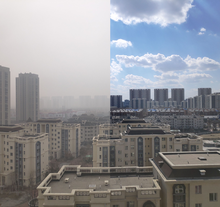
Back ضبخان Arabic Smoq Azerbaijani Смог Byelorussian Смог Bulgarian स्मॉग Bihari ধোঁয়াশা Bengali/Bangla Smog BS Boirum Catalan Smog Czech Смог CV

| Part of a series on |
| Pollution |
|---|
 |
| External audio | |
|---|---|
Smog, or smoke fog, is a type of intense air pollution. The word "smog" was coined in the early 20th century, and is a portmanteau of the words smoke and fog[1] to refer to smoky fog due to its opacity, and odor.[2] The word was then intended to refer to what was sometimes known as pea soup fog, a familiar and serious problem in London from the 19th century to the mid-20th century, where it was commonly known as a London particular or London fog. This kind of visible air pollution is composed of nitrogen oxides, sulfur oxide, ozone, smoke and other particulates. Man-made smog is derived from coal combustion emissions, vehicular emissions, industrial emissions, forest and agricultural fires and photochemical reactions of these emissions.
Smog is often categorized as being either summer smog or winter smog. Summer smog is primarily associated with the photochemical formation of ozone. During the summer season when the temperatures are warmer and there is more sunlight present, photochemical smog is the dominant type of smog formation. During the winter months when the temperatures are colder, and atmospheric inversions are common, there is an increase in coal and other fossil fuel usage to heat homes and buildings. These combustion emissions, together with the lack of pollutant dispersion under inversions, characterize winter smog formation. Smog formation in general relies on both primary and secondary pollutants. Primary pollutants are emitted directly from a source, such as emissions of sulfur dioxide from coal combustion. Secondary pollutants, such as ozone, are formed when primary pollutants undergo chemical reactions in the atmosphere.
Photochemical smog, as found for example in Los Angeles, is a type of air pollution derived from vehicular emission from internal combustion engines and industrial fumes. These pollutants react in the atmosphere with sunlight to form secondary pollutants that also combine with the primary emissions to form photochemical smog. In certain other cities, such as Delhi, smog severity is often aggravated by stubble burning in neighboring agricultural areas since the 1980s. The atmospheric pollution levels of Los Angeles, Beijing, Delhi, Lahore, Mexico City, Tehran and other cities are often increased by an inversion that traps pollution close to the ground. The developing smog is usually toxic to humans and can cause severe sickness, a shortened life span, or premature death.
- ^ Olga Kornienko, Grinin L, Ilyin I, Herrmann P, Korotayev A (2016). "Social and Economic Background of Blending" (PDF). Globalistics and Globalization Studies: Global Transformations and Global Future. Volgograd: Uchitel Publishing House. pp. 220–225. ISBN 978-5-7057-5026-9.
{{cite book}}: CS1 maint: multiple names: authors list (link) - ^ Schwartz Cowan, Ruth (1997). A Social History of American Technology. Oxford University Press. ISBN 978-0-19-504605-2.[page needed]